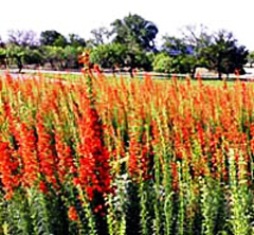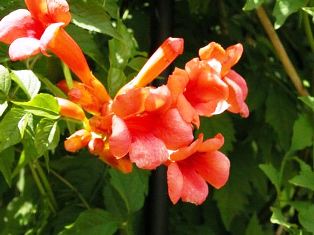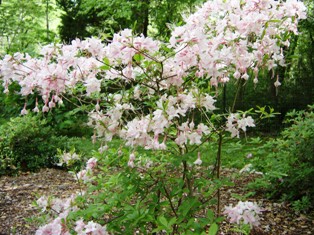 Birders
who want to host hummingbirds in their backyards need to plan
bird-friendly landscaping, especially flowers that attract hummingbirds.
Flowers that are especially adapted for hummingbird pollination are long
and tube-shaped and often red. Browse through our alphabetical list of
native Florida plants and find the ones that are best suited for your
yard or garden! Birders
who want to host hummingbirds in their backyards need to plan
bird-friendly landscaping, especially flowers that attract hummingbirds.
Flowers that are especially adapted for hummingbird pollination are long
and tube-shaped and often red. Browse through our alphabetical list of
native Florida plants and find the ones that are best suited for your
yard or garden!
 Scarlet
Morning Glory (Ipomea coccinea)-
Scarlet morning glory is a twining, smooth to hairy annual vine. The
leaf shape is extremely variable. The leaves are generally ovate in
shape with pointed tips and heart-shaped bases and are commonly deeply
3-lobed. The flower stalks are usually as long as, or longer than, the
subtending leaf. Each flower stalk may bear a simple flower or may have
several flowers. The sepals are oblong and 1.5-3 mm long, excluding the
sharp pointed tip. The tip may be as long as, or longer than, the
broader portion below. The joined petals may be scarlet to yellowish to
orange-red and from 2.5-4.5 cm in length. The fruit is a round capsule
up to 8 mm in diameter containing a few seeds. Scarlet morning glory is
native to Florida and a hummingbird favorite! They arise in abundance in
summer and fall, opening in the morning and tightly closed again by late
afternoon. Scarlet
Morning Glory (Ipomea coccinea)-
Scarlet morning glory is a twining, smooth to hairy annual vine. The
leaf shape is extremely variable. The leaves are generally ovate in
shape with pointed tips and heart-shaped bases and are commonly deeply
3-lobed. The flower stalks are usually as long as, or longer than, the
subtending leaf. Each flower stalk may bear a simple flower or may have
several flowers. The sepals are oblong and 1.5-3 mm long, excluding the
sharp pointed tip. The tip may be as long as, or longer than, the
broader portion below. The joined petals may be scarlet to yellowish to
orange-red and from 2.5-4.5 cm in length. The fruit is a round capsule
up to 8 mm in diameter containing a few seeds. Scarlet morning glory is
native to Florida and a hummingbird favorite! They arise in abundance in
summer and fall, opening in the morning and tightly closed again by late
afternoon.
 Standing
Cypress (Ipomopsis rubra)-
Standing cypress is a sturdy, upright perennial variety native to the
southeastern portion of the United States. It is occasionally found
growing on sandhills and dunes of the northern and central Florida
peninsula and west to the panhandle and Escambia county. The brilliant
red, tubular flowers are marginally spaced throughout the entire length
of the spike. The leaves are finely divided making this variety easy to
identify when not in bloom. Standing cypress requires a very dry,
well-drained soil in full sun to partial shade. Standing cypress is
drought tolerant once it becomes established. An excellent variety to
attract hummingbirds and butterflies to the garden, standing cypress
blooms in the summer. Standing
Cypress (Ipomopsis rubra)-
Standing cypress is a sturdy, upright perennial variety native to the
southeastern portion of the United States. It is occasionally found
growing on sandhills and dunes of the northern and central Florida
peninsula and west to the panhandle and Escambia county. The brilliant
red, tubular flowers are marginally spaced throughout the entire length
of the spike. The leaves are finely divided making this variety easy to
identify when not in bloom. Standing cypress requires a very dry,
well-drained soil in full sun to partial shade. Standing cypress is
drought tolerant once it becomes established. An excellent variety to
attract hummingbirds and butterflies to the garden, standing cypress
blooms in the summer.
 Trumpet
Vine (Campsis radicans)- The trumpet vine, or
trumpet creeper as it is sometimes called, is native to the southeastern
and Gulf Coast region of the United States where it grows along fences
and at the edge of woodlands. Trumpet vine is a much admired garden
plant in most temperate areas of the world. Trumpet creeper is one of
the best plants for attracting hummingbirds to your yard as it produces
quantities of nectar rich blossoms all summer long. The trumpet shaped
flowers are big and beautiful and will attract hordes of hummingbirds
from miles around. The trumpet creeper is a fast growing, high climbing
deciduous woody vine that will grow to heights up to 40 feet. The vine's
aerial roots that occur along the stems that attach tightly to surfaces.
Once the vine climbs to a certain height it grows horizontal branches.
Showy clusters of yellow orange to red trumpet-shaped flowers first
appear in summer (earlier in frost-free climates) and are produced
continuously until early autumn. The tubular flower buds are 3 - 4
inches in size. Trumpet
Vine (Campsis radicans)- The trumpet vine, or
trumpet creeper as it is sometimes called, is native to the southeastern
and Gulf Coast region of the United States where it grows along fences
and at the edge of woodlands. Trumpet vine is a much admired garden
plant in most temperate areas of the world. Trumpet creeper is one of
the best plants for attracting hummingbirds to your yard as it produces
quantities of nectar rich blossoms all summer long. The trumpet shaped
flowers are big and beautiful and will attract hordes of hummingbirds
from miles around. The trumpet creeper is a fast growing, high climbing
deciduous woody vine that will grow to heights up to 40 feet. The vine's
aerial roots that occur along the stems that attach tightly to surfaces.
Once the vine climbs to a certain height it grows horizontal branches.
Showy clusters of yellow orange to red trumpet-shaped flowers first
appear in summer (earlier in frost-free climates) and are produced
continuously until early autumn. The tubular flower buds are 3 - 4
inches in size.
 Wild
Azalea (Rhododendron spp)- Native azaleas are deciduous shrubs
that are in the rhododendron family. It grows along streams and swamp
margins from North Carolina and Tennessee to central Florida, and west
to East Texas. Color variations and natural hybridization makes positive
identification difficult. Found in moist wooded hammocks, the wild
azalea can reach a height of six feet. The blooms of the wild azalea
come in a variety of colors, including pinks and whites. Wild azaleas
bloom in late march and April and attract a variety of butterflies,
along with attracting hummingbirds. Wild azalea needs an acidic soil.
Never add lime. If your soil is alkaline, forget about growing azaleas.
Azaleas do best with plenty of organic matter in the soil. Pile leaves
or pine needles over the root zone, and never cultivate there as they
have very shallow roots. Florida's native azaleas include, but are not
limited to, R. austrinum (flame azalea), an Endangered Species
which blooms bright orange and is very early flowering; and R.
viscosum, or swamp azalea, which is evergreen and blooms in the
summer with small white flowers. Wild
Azalea (Rhododendron spp)- Native azaleas are deciduous shrubs
that are in the rhododendron family. It grows along streams and swamp
margins from North Carolina and Tennessee to central Florida, and west
to East Texas. Color variations and natural hybridization makes positive
identification difficult. Found in moist wooded hammocks, the wild
azalea can reach a height of six feet. The blooms of the wild azalea
come in a variety of colors, including pinks and whites. Wild azaleas
bloom in late march and April and attract a variety of butterflies,
along with attracting hummingbirds. Wild azalea needs an acidic soil.
Never add lime. If your soil is alkaline, forget about growing azaleas.
Azaleas do best with plenty of organic matter in the soil. Pile leaves
or pine needles over the root zone, and never cultivate there as they
have very shallow roots. Florida's native azaleas include, but are not
limited to, R. austrinum (flame azalea), an Endangered Species
which blooms bright orange and is very early flowering; and R.
viscosum, or swamp azalea, which is evergreen and blooms in the
summer with small white flowers.
 |
|


 Birders
who want to host hummingbirds in their backyards need to plan
bird-friendly landscaping, especially flowers that attract hummingbirds.
Flowers that are especially adapted for hummingbird pollination are long
and tube-shaped and often red. Browse through our alphabetical list of
native Florida plants and find the ones that are best suited for your
yard or garden!
Birders
who want to host hummingbirds in their backyards need to plan
bird-friendly landscaping, especially flowers that attract hummingbirds.
Flowers that are especially adapted for hummingbird pollination are long
and tube-shaped and often red. Browse through our alphabetical list of
native Florida plants and find the ones that are best suited for your
yard or garden! Scarlet
Morning Glory (Ipomea coccinea
Scarlet
Morning Glory (Ipomea coccinea Standing
Cypress (Ipomopsis rubra
Standing
Cypress (Ipomopsis rubra Trumpet
Vine (Campsis radicans
Trumpet
Vine (Campsis radicans